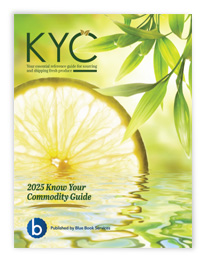Fresh-Cut Produce Market Summary

Image: David Carillet/Shutterstock.com
Fresh-Cut Produce Market Overview
“Fresh-cut” refers to raw fruits and vegetables that are harvested, cut, washed, packaged, refrigerated, and made ready to eat or cook. Its sibling term, “value-added,” covers the same process but emphasizes how this preparation offers convenience and ease of use. Because these items have not been processed by other techniques such as freezing, cooking, drying, or canning, they are more perishable and will spoil quickly if not sufficiently cooled during shipping and storage. Fresh-cut produce may be a single commodity or two or more in the same package such as bagged lettuce blends, cole slaw mixes, or fruit salads.
Types & Varieties of Fresh-Cut Produce
Fresh-cut varieties continue to increase, but the most common include apples, broccoli, carrots, celery, garlic, melon mixes, lettuce salad blends, citrus groupings, and many types of chopped or sliced fruit salads. Cabbages and broccoli are made into a number of creative cole slaw dishes, with other vegetables and fruits thrown into the mix for color and flavor. Stir fry mixes include a broad array of fresh produce, and tropical salads bring old stalwarts like apples and grapes together with berries, kiwifruit, mangos, melon, citrus, papaya, pineapple, pomegranates, star fruit, and more. Soup and stew preparations may include a multitude of vegetables and herbs. Nearly two-thirds of fresh-cut product is packaged salads, with other vegetables like carrots and celery accounting for more than another quarter, with fruit comprising the balance. Top chopped and sliced fruits include apples and melon, with mixed fruit trays making up about a fifth of all fresh-cut fruit offerings. Styles of cuts for fresh-cut produce depend upon the commodity, but can be broken down into several different categories, including:- balls – used for cantaloupe, honeydew, and watermelon; pieces are cut into bite-sized spheres that are ridged or smooth
- buds, florets, or crowns – used for broccoli and cauliflower; usually attached by part of the stem and include flowers or clusters from the head
- chopped or shredded – used for cabbage, carrots, lettuce, romaine, and other leafy vegetables; items are cut into squares, rectangles, irregular shapes, or long narrow shreds
- coined, cross-cut, rings, or slices – used for broccoli stems, carrots, celery, onions, sweet peppers, potatoes, and tomatoes; cross-cut, uniform pieces may be smooth or ridged and slices can be cut straight across the item or at an angle
- diced, cubed, chunks, or wedges – used for broccoli stems, celery, melons, pineapples, potatoes, onions, and tomatoes; commodities are cut into square or rectangular shapes or irregular chunks
- julienne, slivered, strips, spears, stalks, or sticks – used for broccoli stems, carrots, celery, onions, sweet peppers, pineapples, or potatoes; cuts are length-wise either with ends intact, squared off, or tapered
- whole-trimmed and cleaned, whole-trimmed and cored, or whole peeled – used for cabbage, carrots, cauliflower, celery, garlic, grapes, lettuce, romaine, and other leafy greens, onions, potatoes, and strawberries; the original shape of the item is generally maintained but washed and cut, with excess leaves and/or stems removed
- random cut – can be any commodity cut into random shapes and sizes.
Cultivation of Fresh-Cut Produce
Commodities for fresh-cut processing are put through a series of steps that begin immediately after harvest. Whole produce, placed in bins for transport to the processor, are emptied onto conveyors for rinsing, trimming, coring, and removal of excess parts such as stems, peels, and outer leaves. Next, trimmed produce is put through cutting machines for the desired form (balls, cubes, slices, florets, etc.), inspected for uniformity, then thoroughly washed (up to three times). Clean produce is spin- or air-dried and placed into plain or modified atmosphere packaging, specially designed to preserve freshness and quality. Perhaps the most important condition for quality fresh-cut is temperature control—to reduce microbial growth and maximize shelf life. Products should be prepared at a refrigerated temperature from 35 to 44°F. Sanitized water for washing should be approximately 32°F. Cutting blades must be sharp to minimize injury. Sliced or chopped fruits are more susceptible to bruising and injury than root vegetables or leafy greens. Proper equipment and employee sanitation practices are particularly important; mild disinfection agents (like chlorine) are added to rinse and wash water, while other additives such as ascorbic or citrus acid can help minimize discoloration and texture loss.Pests & Diseases Affecting Fresh-Cut Produce
By definition, fresh-cut produce is injured—the act of cutting, peeling, or slicing wounds fruits and vegetables and can transfer pathogenic microorganisms from the item’s surface to the tissue inside. Pathogens can multiply quickly and thrive in fresh-cut produce. Edible coatings can provide a modi?ed atmosphere around surfaces to help preserve and extend shelf life; the coatings act as a barrier to oxygen or water loss, as well as gas exchange. Cellulose-based edible coatings are generally used on cut apples while edible wax is preferred for citrus. The most common spoilage symptoms include:- browning, discoloration, yellowing – common in apples, asparagus, beets, snap beans, broccoli, shredded cabbage, cauliflower, celery, garlic, jicama, leeks, lettuce, mushrooms, bulb onions, green onions, peaches, pears, peppers, persimmons, pineapple, pomegranates, potatoes, rutabagas, strawberries, and summer squash
- softening, texture loss, translucency – common in asparagus, jicama, kiwi, melon, bulb onions, peppers, persimmon, strawberries, and watermelon
- leakage – common in beets, carrots, cucumbers, kiwi, melon, bulb onions, green onions, oranges, pomegranates, summer squash, strawberries, tomatoes, and watermelon
- off-odors – common in broccoli, cauliflower, and spinach
- drying and cracking – common in carrots, celery, potatoes, and rutabagas
- sprout growth – common in garlic and green onions.

